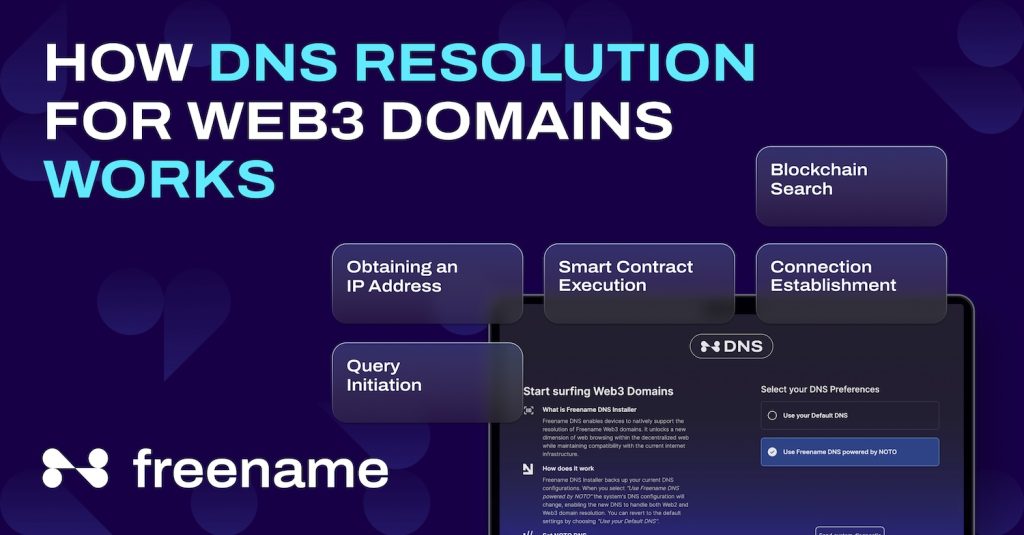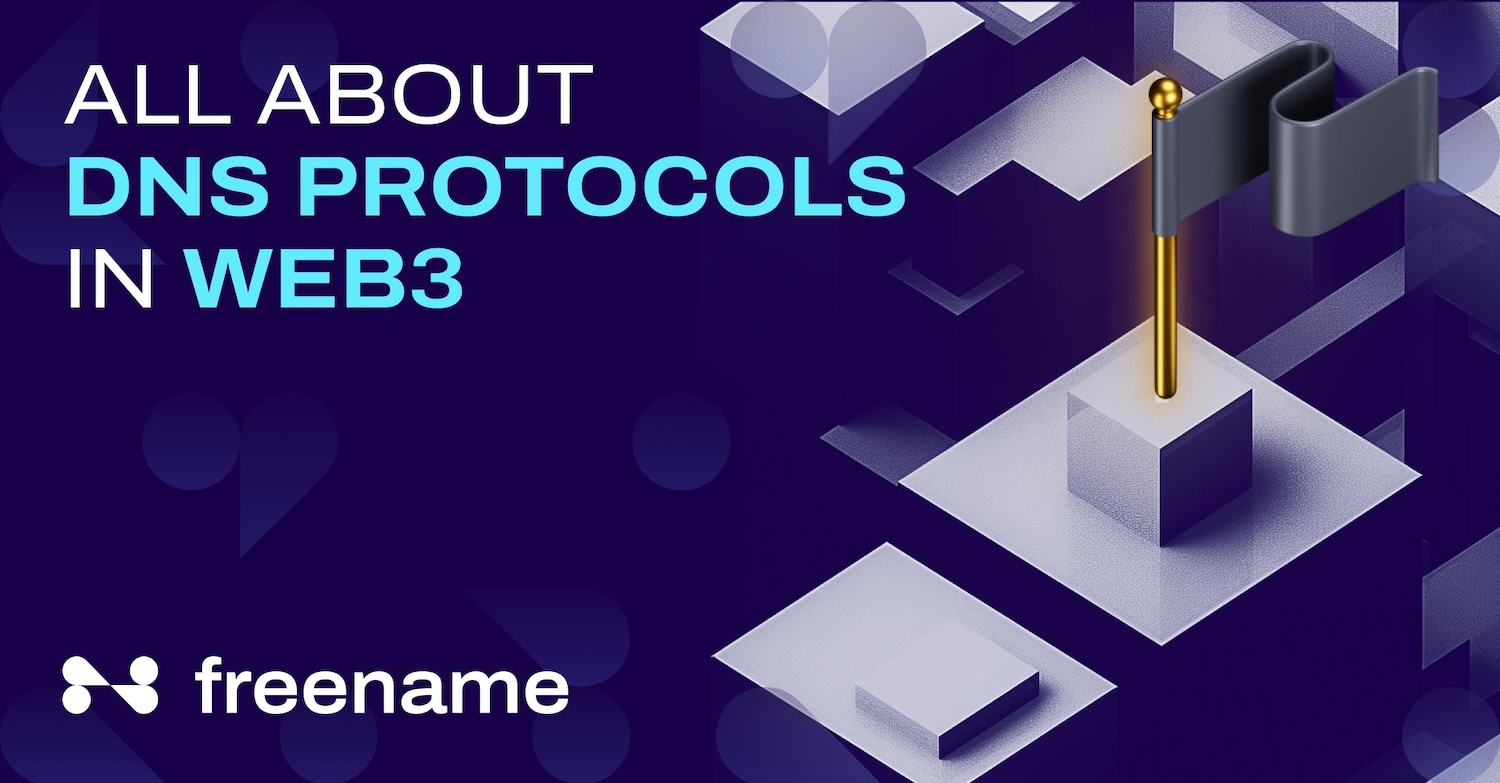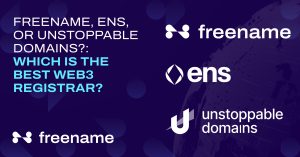Every webpage is basically a long string of numbers. But that is the kind of mayhem from which the Domain Name System (DNS) rescues us.
It’s the internet’s phonebook and helps convert domain names (which are easier for humans to remember) into numerical IP addresses (which computers use to communicate). The Domain Name System (DNS) has played a crucial role in the Internet since the Web2 era and it’s always been responsible for the prompt and accurate direction of our digital requests.
The advent of Web3 has simply made DNS much more important than it already is, in a different way. Web3 brings forward a distributed internet in which people control their data and blockchain technology guarantees openness and security. In this ecosystem, the Web3 domain is the key to a new type of digital ownership and identification; it is more than just an address.
This article will explain how to resolve Web3 domains using DNS and offer some understanding of how this vital infrastructure is changing to meet the needs of a decentralized internet. We will also demonstrate the technologies that let Web3 domains answer DNS requests.
Understanding Web3 Domains
Web3 domains represent a change in the dynamics of domain ownership and the subsequent generation of internet addresses. These domains are constructed on the same blockchain that underpins digital currencies such as Bitcoin and Ethereum. You can use a Web3 domain for more than just pointing to websites; it can also serve as a digital identity and be used to receive cryptocurrency directly.
Differences Between Web2 and Web3 Domains
Web3 domains are very different from Web2 domains. The Domain Name System (DNS) functions as an intermediary in Web2 that controls the allocation of IP addresses. Though effective, it concentrates power in the hands of a small elite.
In contrast, Web3 domains operate on a distributed model. Because the blockchain disperses the data among multiple computers and it’s based on the concept of tokenization, there is no central authority. This makes Web3 domains more resistant to attacks and ensures that they cannot be arbitrarily taken away from you giving you full control over your identity and space.
How you get these domains is another significant distinction. It is common practice to pay an annual fee to maintain your Web2 domain. On the other hand, Web3 domains are permanent; once you buy them, you own them forever. Once you add it to your digital identity, you won’t have to worry about renewal notices or payments again.
The Importance of Decentralization in Web3 Domains
Web3 domains are distinct due to their distributed nature. The idea is to disperse power rather than store it centrally. And this has a number of advantages.
First, it strengthens the system’s ability to withstand failure; when one node in the network goes down, the others continue to function normally. With no overarching authority to pry into users’ lives, it offers them greater autonomy and privacy.
As another benefit of Web3’s decentralization, users can participate in important policy matters. They have a voice in network decisions and can even get perks for making the network more secure and efficient. Because of this, the network becomes community-driven, and everyone’s success is directly tied to the network’s.
The Role of DNS in Web3
If you’re familiar with the classic web, you know DNS resolution is analogous to requesting directions. By converting the domain name into an IP address—essentially a pinpoint on the internet map, DNS directs your browser to the desired website when you enter its name into your browser.
Several servers and processes are involved in this process, such as a DNS recursor, root nameserver, TLD nameserver, and authoritative nameserver.
Consider instead a scenario in which all users, rather than a single entity, are in charge of this method of requesting guidance. That is the use case for blockchain-based DNS resolution.
Unlike traditional methods, this one doesn’t depend on a single authority to provide directions online, just like Freename provides a DNS for Web3 that can resolve any domain name directly in your browser without the requirement for any other plugins or add-ons.

Blockchain technology is used to store data across a network of computers regarding domain names and their associated IP addresses. Because of this, the data is accessible to everyone, impenetrable, and error-proof.
The Function of Smart Contracts in DNS Resolution for Web3
This decentralized DNS system relies heavily on smart contracts. In a way, they serve as Web3’s regulations. Without a human intermediary, smart contracts can perform transactions automatically when specific circumstances are satisfied.
Smart contracts can handle the registration, renewal, and transfer of ownership of domain names on the blockchain within the framework of DNS resolution. Their diligent attention to detail guarantees that the procedure is open and reliable.
How DNS Resolution for Web3 Domains Works Step by Step

Web3 domain names initiate a chain reaction that culminates in the display of the requested website in the user’s browser. In the same way that you might ask a store clerk for directions, your request will go to multiple digital places before arriving at the correct address.
But how does Web3’s DNS resolution function in practice? Here is the process:
Step 1: Query initiation
The process begins with entering a Web3 domain into a browser that is compatible with DNS resolution based on blockchain technology. In order to find the real address of the website, your browser takes on the role of a detective.
Step 2: Blockchain search
The browser communicates with a blockchain network rather than a conventional domain name system (DNS) server. The blockchain stores all the information about Web3 domains in a huge, secure ledger. No one party can compromise it because it is decentralized and impossible to mess with.
Step 3: Smart contract execution
In order to access the domain information kept in their “books,” or the blockchain ledger, smart contracts use the blockchain. The smart contract will get the IP address associated with the domain if it finds it.
Step 4: Obtaining an IP address
The smart contract will communicate the domain’s IP address to the browser once it has verified it. Important as it is, this IP address is a numerical designation that pinpoints the exact location of the website on the internet.
Step 5: Connection establishment
Now that your browser has the IP address, it may connect to the website. It is as if you have been waiting for the party directions and have finally found them.
In this video, Patrick explains how the Freename Web3 DNS works and how it resolves domains in depth:
Technologies Enabling DNS Resolution in Web3
We have taken a look at the inner workings of Web3 DNS resolution. But we should also note that new technology advancements are also simplifying things. Important technologies for Web3 DNS resolution include IPFS and ENS, or Ethereum Name Service.
Domain Name System Distributed (DDNS)
The DDNS is an alternative to a centralized server that processes domain name system inquiries is a network of nodes, which is known as a decentralized DNS system. By using blockchain, decentralized DNS systems ensure that records are stored across a network of nodes, making them resistant to tampering and centralized control. This distributed approach enhances security and reliability, as there is no single point of failure.
In decentralized DNS systems, users can assign human-readable names to their wallet addresses. This simplifies the process of transferring and receiving cryptocurrency, reducing the risk of errors associated with long and complex addresses. These user-friendly names make cryptocurrency transactions more accessible and user-friendly.
InterPlanetary File System (IPFS)
IPFS is a decentralized network where users can access and exchange files, webpages, apps, and data. In order to remove all possible barriers to file sharing, IPFS creates a decentralized network where users can communicate directly with one another, doing away with the necessity for central servers. Web3 domains are essential for hosting decentralized websites and apps.
Content-Addressable Networks (CANs)
The content-addressable network (CAN) is a distributed system that can store and retrieve data regardless of its physical location. With a CAN, content retrieval is made possible by directing queries via the network.
Each node stores material addressable by its cryptographic hash. As a general rule, Web3 configurations use CANs in conjunction with decentralized DNS and peer-to-peer protocols to make content resolution and discovery easier.
Protocols Involved in the Process
The protocols that enable these technologies to function are the skeleton of Web3’s DNS resolution.
For example, The InterPlanetary File System (IPFS) uses a protocol called libp2p (library peer-to-peer), which handles network communications in a distributed environment. This protocol allows nodes to discover each other and communicate directly, facilitating the retrieval of content addressed by a unique identifier rather than a location. This means that when you access a Web3 domain, the content can be served from anywhere in the network, not just a specific server.
Web3 Domain Resolution: The Future Is Here
Web3’s DNS resolution is a truly revolutionary new feature that changes the way domain names are handled and resolved. Using blockchain technology, it creates a decentralized system that makes sure name ownership is clear and safe.
Technologies like IPFS are not just improvements in technology; they are also the building blocks of a more open internet. These advancements have the potential to change the way we interact online by making it safer and more user-centric. As these technologies become more integrated into our digital lives, they promise to pave the way for a more secure, transparent, and decentralized web. This transformation could redefine the internet, creating a more equitable digital landscape for all users.







